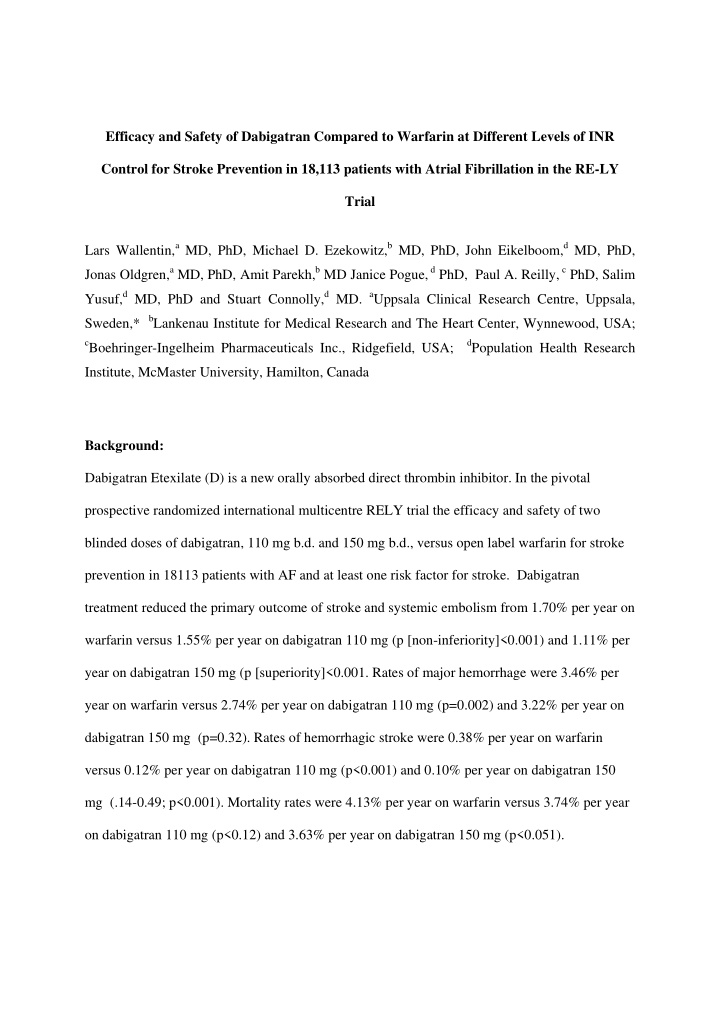



Efficacy and Safety of Dabigatran Compared to Warfarin at Different Levels of INR Control for Stroke Prevention in 18,113 patients with Atrial Fibrillation in the RE-LY Trial Lars Wallentin, a MD, PhD, Michael D. Ezekowitz, b MD, PhD, John Eikelboom, d MD, PhD, Jonas Oldgren, a MD, PhD, Amit Parekh, b MD Janice Pogue, d PhD, Paul A. Reilly, c PhD, Salim Yusuf, d MD, PhD and Stuart Connolly, d MD. a Uppsala Clinical Research Centre, Uppsala, Sweden,* b Lankenau Institute for Medical Research and The Heart Center, Wynnewood, USA; c Boehringer-Ingelheim Pharmaceuticals Inc., Ridgefield, USA; d Population Health Research Institute, McMaster University, Hamilton, Canada Background: Dabigatran Etexilate (D) is a new orally absorbed direct thrombin inhibitor. In the pivotal prospective randomized international multicentre RELY trial the efficacy and safety of two blinded doses of dabigatran, 110 mg b.d. and 150 mg b.d., versus open label warfarin for stroke prevention in 18113 patients with AF and at least one risk factor for stroke. Dabigatran treatment reduced the primary outcome of stroke and systemic embolism from 1.70% per year on warfarin versus 1.55% per year on dabigatran 110 mg (p [non-inferiority]<0.001) and 1.11% per year on dabigatran 150 mg (p [superiority]<0.001. Rates of major hemorrhage were 3.46% per year on warfarin versus 2.74% per year on dabigatran 110 mg (p=0.002) and 3.22% per year on dabigatran 150 mg (p=0.32). Rates of hemorrhagic stroke were 0.38% per year on warfarin versus 0.12% per year on dabigatran 110 mg (p<0.001) and 0.10% per year on dabigatran 150 mg (.14-0.49; p<0.001). Mortality rates were 4.13% per year on warfarin versus 3.74% per year on dabigatran 110 mg (p<0.12) and 3.63% per year on dabigatran 150 mg (p<0.051).
Objectives and methods: Warfarin is effective for stroke prevention in atrial fibrillation (AF) but has a narrow therapeutic range. The best balance between risk of stroke and bleeding is obtained by obtaining a maximal time in therapeutic range (TTR) i.e. with INR 2.0 – 3.0. In the RELY trial there were large variations in TTR in the warfarin arm between different countries and sites, which might have influenced the overall results. We therefore performed a post-hoc evaluation of outcome in relation to center based TTR (cTTR). Each center’s average of TTR in the warfarin arm (Rosendaal method) was applied as a proxy for all patients in each center. The outcomes were presented in relation to quartiles of cTTR and interactions between cTTR and the effects of dabigatran were evaluated by a multivariable approach using cTTR as a continuous variable. Results: The quartiles of cTTR for the warfarin patients were <57%, 56 - 65%, 65 - 73% and >73%. Concerning the primary endpoint, stroke and systemic embolism, there was no significant interaction between cTTR and the effects of Dabigatran and accordingly Dabigatran 110 seemed non-inferior and Dabigatran 150 superior to Warfarin irrespective of centre based INR control. Similarly concerning intracranial haemorrhage there was no significant interaction and both doses of Dabigatran 110 and 15 therefore seemed superior to warfarin irrespective of centre based INR control. Also concerning major bleeding there was no significant interaction and accordingly Dabigatran 110 seemed superior and Dabigatran 150 similar to Warfarin irrespective of centre based INR control. Concerning all vascular events and mortality there were significant interactions between cTTR and the effects of both doses of Dabigatran. Accordingly concerning
these events both Dabigatran doses seemed superior to Warfarin at sites with poor and similar at average - good INR control Limitations: In needs to be emphasized that these analyses are associated with many limitations. The analyses are exploratory and based on post-hoc analyses including several secondary end-points. The use of average of cTTR in the warfarin group as a proxy for INR control both in the warfarin treated and dabigatran treated patients has many limitations. Thus, cTTR does not appropriately reflect individual patients INR control and thereby not the full effect of INR control on outcome. Neither does cTTR reflect the impact of good and poor response and adherence to dabigatran and not the effect of treatment discontinuations. Finally cTTR constitutes as post-randomization defined variable which also is associated with differences in other confounding variables between centres which might not be completely compensated for in the multivariable analyses. Therefore these analyses verify the well-known effects of individual and centre based INR control on outcome events in the Warfarin arm, but the identification of the appropriate control patients in the dabigatran arms is challenging. Conclusions: For the primary efficacy and safety results, the main RELY study results are consistent, showing reductions in stroke and major bleeding with Dabigatran compared Warfarin irrespective of centre based INR control. For secondary outcomes such as all vascular events and mortality the advantages of Dabigatran may be greater at sites with poorer INR control.
Recommend
More recommend